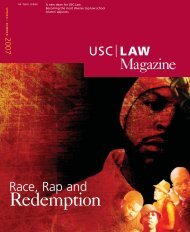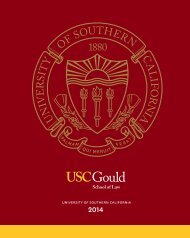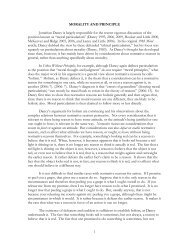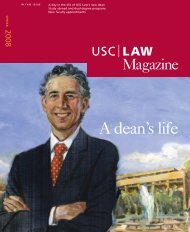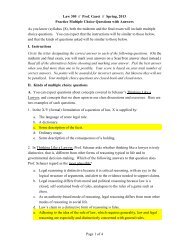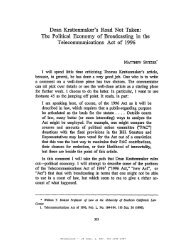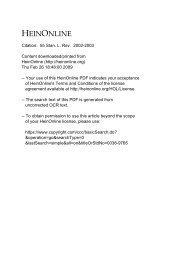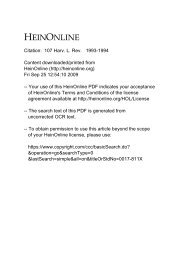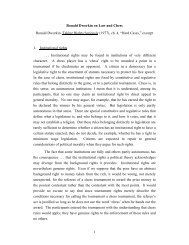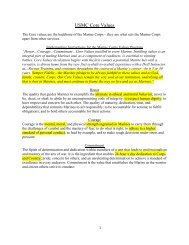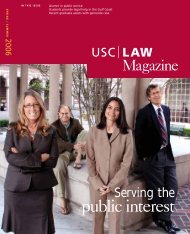usclaw - USC Gould School of Law - University of Southern California
usclaw - USC Gould School of Law - University of Southern California
usclaw - USC Gould School of Law - University of Southern California
You also want an ePaper? Increase the reach of your titles
YUMPU automatically turns print PDFs into web optimized ePapers that Google loves.
NE W S FROM THE LAW SCHOOL<br />
C a reer Services Update<br />
To p s y -Turvy Legal Market Af fects Job Searching and Hiring Pr o c e s s e s<br />
by Eden Ku s m i e r s k y<br />
D i r e c t o r, Career Services and Lisa Mead<br />
Assistant Dean, Career Services<br />
One <strong>of</strong> the most important issues facing the <strong>Law</strong> <strong>School</strong>’s students, graduates and legal<br />
e m p l oyers, both locally and nationally, is how the legal job market has been affected by the<br />
recent fluctuations in the economy. If you are not a recent law school graduate, you may be<br />
scratching your head and asking, “What is going on in the legal market?” In anticipation <strong>of</strong> this<br />
question, we in the career services <strong>of</strong>fice have been tracking recent trends. The legal market has<br />
been topsy-turvy during the past 14 months, and we have tried to make sense <strong>of</strong> the changes<br />
and turmoil that have characterized the legal market in recent months. The following are some<br />
<strong>of</strong> our observa t i o n s .<br />
Trends in 2000: The dot.coms and their legal needs played a significant role in the chaos<br />
<strong>of</strong> 2000. The dot.com demand for in-house and out-<strong>of</strong>-house counsel sky-rocketed — as did<br />
the stock value and the issuance <strong>of</strong> stock options to legal counsel (in-house and out-<strong>of</strong>-house).<br />
The booming economy <strong>of</strong> some business markets, such as Silicon Va l l e y, and an increase in the<br />
globalization <strong>of</strong> business prompted law firm expansions into new regions and countries.<br />
As the need for lawyers increased, law firms redoubled efforts to hire summer associates and<br />
n ew and lateral associates. Many national firms went to great lengths to re c ruit law students.<br />
Some substantially increased salaries — in some cases to as much as $165,000 to $170,000<br />
for fir s t - year associates. Many adopted business-casual dress codes throughout the week, and<br />
some provided more personal services, including limousine service or commuting expense re i m-<br />
bursement, personal shoppers, on-site food, dry cleaning or masseuse serv i c e s .<br />
Trends in 2001: Tow a rd the end <strong>of</strong> 2000, we began to see the phrase dot.gone being used<br />
m o re fre q u e n t l y. The downturn in dot.com legal work, along with the general economic<br />
s l owd own, has created a much more competitive legal market for 2001. Many law firms are<br />
suffering from the sticker-shock <strong>of</strong> the 2000 salary wars and some have undergone mergers<br />
or acquisitions, significant partner movement, associate and partner lay<strong>of</strong>fs or even <strong>of</strong>fice or<br />
firm closures. As a result, billable hours re q u i rements have increased to as much as 2,200 to<br />
2,400 hours per ye a r. Many associates re p o rt experiencing a reduction in mentoring, training<br />
and time for pro bono work, and some say that law firm partnership seems either unattainable<br />
or not worth the effort. A number <strong>of</strong> firms, in an effort to be more cost-effective, are<br />
focusing on retention programs and lateral associate hiring; some firms are reducing their<br />
summer associate hiring.<br />
Sa l a ry increases seem to have had a broader impact as well. Some judges re p o rt a decrease in<br />
applications from students and graduates for externships and judicial clerkships, and many<br />
g overnment and public interest agencies and other legal employers re p o rt difficulty in re c ru i t i n g<br />
n ew attorneys. Legal services agencies and non-pro fits indicate that it is more difficult to seek<br />
donations or volunteer legal work from law firms, and tax consulting businesses have slowe d<br />
their hiring <strong>of</strong> law students and new lawyers because <strong>of</strong> the difficulty in competing with national<br />
law fir m s .<br />
While these are just a few <strong>of</strong> the trends that characterize the current legal market, they are<br />
making for interesting and unpredictable times for law students and lawyers and will continue<br />
to affect job searching, legal re c ruiting and legal practice in 2001. As we lead the <strong>Law</strong> <strong>School</strong>’s<br />
e f f o rts to pre p a re our students for this changing market, we may be contacting some <strong>of</strong> yo u<br />
to assist us with programs and workshops designed to educate and pre p a re our students for a<br />
successful transition into the pro f e s s i o n .<br />
<strong>USC</strong>LAW s p r i n g 2001<br />
4 7




